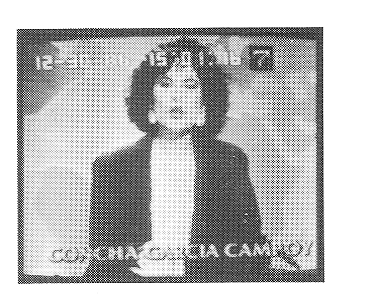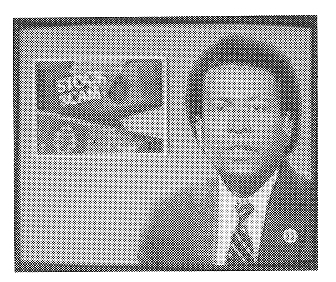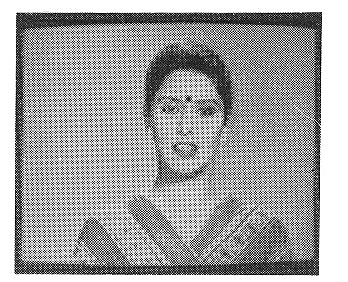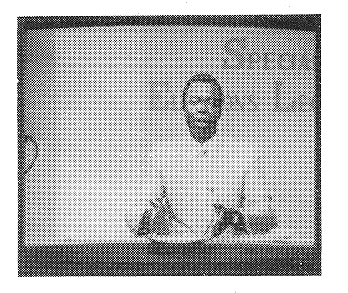You've only just returned from a trip to Canada, Japan, and the United States. In Vancouver you prepared the new issue of Infermental, together with HANK BULL of WESTERN FRONT VIDEO.
Yes, this is the sixth issue of Infermental since 1980, apart from a few special issues that appeared as supplements. WESTERN FRONT edited Infermental VI, and I traveled to Canada for the final editing. Invitations to participate had already been sent out to a few hundred artists in august 1986, ensuring that the basic materials were available. Four themes were specified in the invitations: Cross Culture Television, New Religion, Poetical Economy, and Telepathic Music.
The last two subjects were eventually incorporated as categories in Infermental VI. In addition, the material submitted led to the setting up of three more categories: Myxology, Fractal Grammar, and Satellite Control. Cross Culture Television, originally intended as a regular item in Infermental, was left out.
Why?
For practical reasons. We received contributions for this subject from 31 countries. It would have been futile to reduce it to the same length as the other thematic pans of the program. Also, it would be asking too much to add two extra hours, devoted to a single theme, to a program which in any case already lasts for five hours. Therefore we decided to use this material for a special issue, sold separately, From the point of view of contents, it also seemed better to separate the materials. Infermental VI is almost exclusively concerned with video art. A theme confined to television would have been an odd man out.
What were the criteria used in selecting the tapes?
WESTERN FRONT invented an editorial concept called New World Edition. This refers to a kind of cultural world map. An explanation could be that Canada is a classic example of an immigration country. Not taking into account the indigenous Indians, Canada is a nation with a very young culture. While it is true that the Indian culture was not exterminated as heavy handedly as in Central or South America, 'civilization', and especially industrialization, did turn their culture into a marginal phenomenon. This is painfully obvious from the presence of Indians everywhere in the streets of Vancouver. Even though it was not among the topics of Infermental VI, this gap was so evident everywhere, that we used images of the streets of Vancouver as a kind of jingles between the several contributions, in order to draw attention to this problem.
The basic idea behind Infermental, a yearly issue, each time edited by a different editorial board, and in a different country, each time with a different concept and different sponsors (for Infermental VI this was the CANADA COUNCIL), has again proved to be right. The choice of Vancouver and the WESTERN FRONT, obviously caused North America to be more strongly represented, in terms of quantity as well as in terms of choice of subject and design. To our surprise, however, we received many contributions from Japan. This is probably due to the fact that Vancouver is situated on the West Coast, and in this way is in connection with all countries around the Pacific. There is a kind of Pacific connection that can also be observed in work from Indonesia, Australia, and Japan.
For the Cross Culture Television program, this location proved very convenient and instructive. Without great difficulties we were able to include contributions from South-American and Asian television, From a location in Europe this would not have been possible,
How does WESTERN FRONT operate?
WESTERN FRONT is a non-profit organization, a multi-media-workshop, which not only produces videos, but also invites writers, and for example organizes drama and dance workshops.
What are its aesthetic and theoretical principles?
HANK BULL, ERIC METCALFE, and KATE CRAIG, who spend half their time in India, and frequently worked in Africa, are not representative of the typical Canadian lumberjack mentality. Nor of a cult of artificiality, for that matter. Of course this is obvious from the design of Infermental VI. The themes that were originally planned and also those that were included in the issue later on, clearly indicate the aesthetic principles and world view of this group.
How have the themes been filled in?
Poetical Economy clearly bears the stamp of the artist ANTONI MUNTADAS, who for a long time was artist in residence at WESTERN FRONT, and is now teaching in San Diego. He borrowed the phrase Poetical Economy from ROBERT FILLIOU. In this way all these aesthetic concepts have their own history.
How did Telepathic Music originate?
This is connected with the general craving for the occult, the tremendous boom of astrology and other spiritual sciences that have caught on lately. We use the word 'telepathy' because it is a link between these different expressions. This is also reflected in the music. Many video tapes are nonverbal. The phrase Telepathic Music does not refer to actual music, however. What happens is that the spectators, while they are watching the images, get musical associations, caused by processing of the images, or by internal associations in the video. What is meant is not actual music, but the association with music.
This interest in associations can be observed in all themes in Infermental. No carefully worked out instructions are given to the artists invited. The theme selected should rather evoke associations in the artist's mind, associations which he then gives form in his own way.
Three new themes have emerged from the selection of the works submitted.
Satellite Control simply announced itself. From many works it appeared that the artist either controlled his direct environment, or that he felt he was controlled- by TV, satellite or whatever. Controlling and being controlled was a recurrent theme, whether this took place at the level of nature, of a city, or of a box of matches.
Myxology is a play on words by HANK BULL and myself. It is composed of the words myth, mix, and logic, and any other words you may find in it. The term was originally applied to work in which different ideologies are mixed and processed without turning them into something concrete and different. Characteristic of this work is the joy of playing with this mixing process.
Fractal Grammar is my favorite category at present. The idea comes from MANDELBROT, who already decades ago adduced evidence for the stratification and refractions of concepts from physics, and coined the phrase fractal dimension to refer to this concept. At present he works for American science. In the meantime it has become possible to express the fractal dimensions in electronic diagrams. The model of the MANDELBROT tree, by which is meant the smallest denominator of the fractal dimension, has made a profound impression on the people from WESTERN FRONT and myself. We came across this concept when we did a crash course in computer graphics. Our course instructor BOB RICHARDSON, a supporter of MANDELBROT, almost drilled the concepts into our minds. While we were selecting the tapes, it became clear that there are many new kinds of grammar in the field of video, although they cannot be directly traced to MANDELBROT. Many artists develop new formulas for the production of video tapes just like equations are developed from new insights in physics - which can also be expressed visually. In this way, artists are actually working according to MANDELBROT's theory of knowledge. Every artist develops his own control system, which forms the semantic instrumentation for his interaction with video. It was our intention to associate the subjective impulse of the artists with scientific knowledge. This explains the theme Fractal Grammar.
This concept shows that you pay attention to the composition of the tapes. The video festival in Bonn 1986 showed a similar development of the video images themselves. Did that strike you as well in Fractal Grammar?
No, we were mainly concerned with the choreography, the dramatization, and the total structure of the works concerned. Especially where this subject was concerned, we paid less attention to the separate images. In Myxology, we did pay attention to this aspect. In Fractal Grammar, the production process and its conditions played a more important role.
How was the concept of topicality interpreted in Infermental VI?
Almost all the selected tapes are from 1986. In this respect the issue is of topical interest. Therefore, indirectly, current trends, the Zeitgeist, are much in evidence in the program. A few older works incorporated in the program meet the second important objective of Infermental, which is to include older work that has not been presented to the public provided that it fits in with the context of the issue. This topicality is largely responsible for the reputation Infermental has of being a forum for video art.
What is the relation of Poetical Economy and Telepathic Music to topicality? Do the aesthetic principles of the Fifties surface again, such as FLUXUS and informal art, or does Infermental VI attempt to continue the discussion of this subject?
Certainly there are many young artists who look for examples towards the Fifties. Just as others look towards the Twenties. We were not interested in a thematic study of old aesthetic discussions. I think the Zeitgeist plays a more important part here, though innovation as well as plagiarism are substantial components of art history. It is often in the confrontation of innovation and plagiarism, that brilliant, innovative and topical works originate.
Poetical Economy makes me think of the Eighties rather than the past, because it refers to the discussion about economy and ecology. This conflict is still fairly young. Only recently has this problem become of critical importance. At present a tendency can be discerned for man to see the earth as an organic unity. Mankind rejects the mentality that leads to the exhaustion of nature, a mentality that goes back to the Stone Age. Artists should not attack these problems in the way politicians do, but with their own means. Therefore this category is called Poetical Economy.
When will Infermental VI appear?
It first appeared in Canada on February 6, 1987, in the BANFF-CENTRE in Alberta. The world premiere was at the Berliner Filmfestspiele at the end of February. It is already fully booked for the rest of the year. This is mainly the result of the good relations North America has with Australia, Japan and South America. We now have many more presentations there than with the other issues of Infermental. This is of great importance for an international publication. The next productions will be made in the us and Japan: Infermental VII by the film and video department of the NEW YORK UNIVERSITY, Buffalo, and Infermental VIII by the OM/RICE group, in cooperation with the HARA MUSEUM, GALLERY SCAN, and the GOETHE INSTITUT in Tokyo.
In Tokyo you presented Axis, a combination of paperback and video tape with an anthology of 21 European art videos, published by 1986 by DUMONT in Cologne.
I had been invited to present Axis by the Workshop for Architecture in Tokyo. The general public was extremely interested, which was amazing, as it had not received widespread publicity. Attention was not so much focussed on me - I am completely unknown there. Instead it was focussed on the theme of European video art. With an intensity that can only be found in Japan.
Very specific questions were put about European artists, even about artists who are not very well known in Europe. DALIBOR MARTINIS and SANJA IVECOVIC, for example, are quite famous in Japan after they won a prize at the seventh Tokyo video festival in 1984.
The fact that the prize was awarded to two Yugoslavs, instead of a Japanese or an American, is characteristic for the well trained and critical Japanese public. The high cultural level provides many opportunities for real artistic qualities, at least where video is concerned, more so than many other festivals. The Japanese are far ahead of us, visually, aesthetically and in the field of design. Their standards are a great deal higher than ours. And because the Japanese are very much interested in European culture, the confrontation with this subject is much more intensive, and the discussion more developed than here. Therefore it was a challenge for me to discuss a novelty like Axis with them. Several Japanese publishers have already expressed their intention to translate the book in Japanese, because they feel that the theme of European video art will appeal to many Japanese. We are already discussing this with them.
Later I also presented Axis in the United States, at the national video festival in Los Angeles. There too European video art receives a great deal of attention. I must add that in Los Angeles, only the video part of Axis was presented. I did bring the book, but few people were able to read German. People leafed through it out of politeness. In Los Angeles as well, people were interested in an English version.
The idea of producing a publication about and on video, the two media supplementing each other, is of course more interesting than the separate texts. It was more interesting to the Japanese and the Americans to discuss this concept than the actual contents. I was more interested in explaining GáBOR's and my own concept. A publication about video, which is intended to remove the general reservations about this medium. Reservations that are the result of the fact that video is still associated with porno, horror, and violence. Axis intends to demonstrate that video does not always mean: when you have seen one, you have seen them all. Axis proves that watching video is like reading a book, which you can read several times without the book losing any of its force of expression. This notion introduced Gábor and myself to the idea of book shops. In America people had never regarded video in this way. From the point of view of marketing, the notion of selling a video tape together with a book in a book shop, was interesting to them. Therefore, the GOETHE INSTITUT invited me to present Axis at the New York book fair as well.
Can we expect more experiments, or do they end with Axis?
It is obvious that Axis is not a financial success for the publisher. The idea is too young for that. Nevertheless we are already planning two new publications, on the model of Axis. The next publication will be devoted exclusively to Music. As far as definition is concerned, in the field of music clips the chaos is even greater than for other forms of moving images. Therefore we shall make a kind of historical anthology about the subject Music and Moving Images. It will start with the Twenties and the experimental film, and will proceed to our own era with the latest trends in the field of music clips. The difference with Axis is that we have opted for one subject, and the historical perspective of this theme. The setup is the same: a tape with an anthology of images, with short introductions and supplemented by a book.
The next project will exclusively be devoted to architecture. A development can therefore already be observed. Axis has five more subjects that must be developed. The next publications will each deal with one subject, which will be studied in depth.
If you'd like to quote something: Malsch, Friedemann. "Infermental 6." Mediamatic Magazine vol. 1 # 4 (1987).
Translation: Fokke Sluiter













